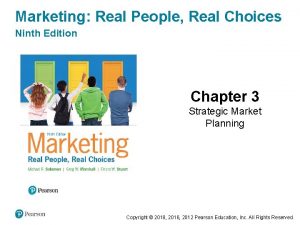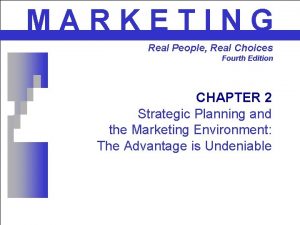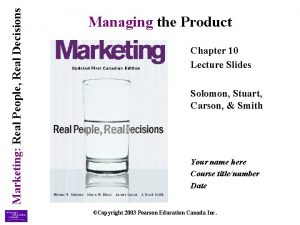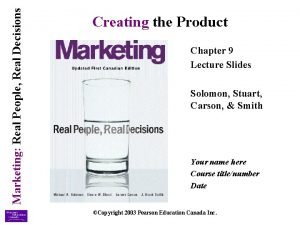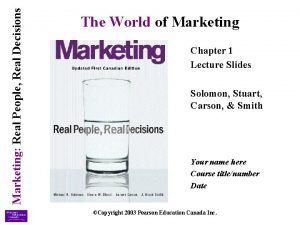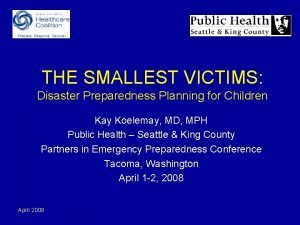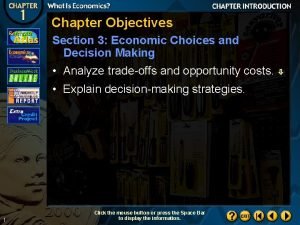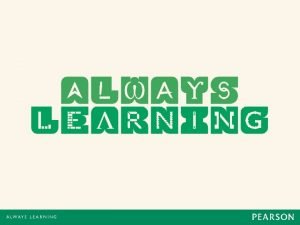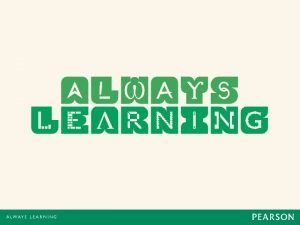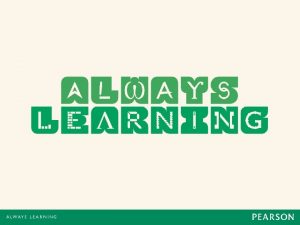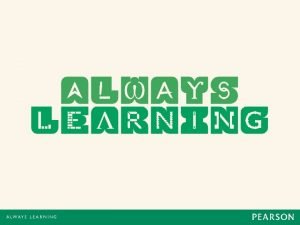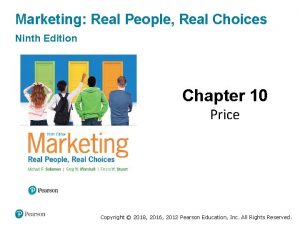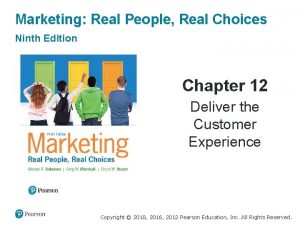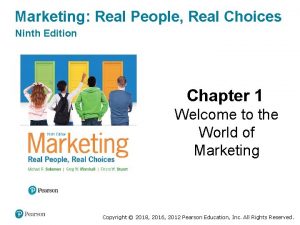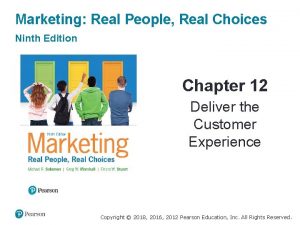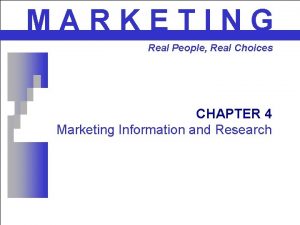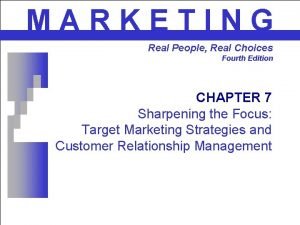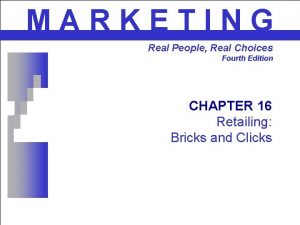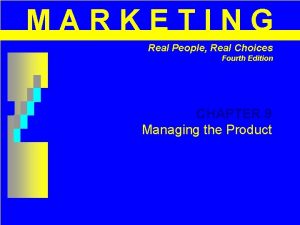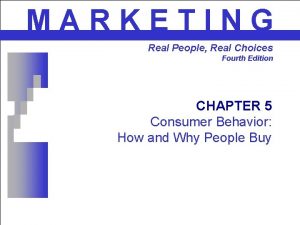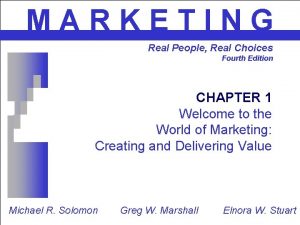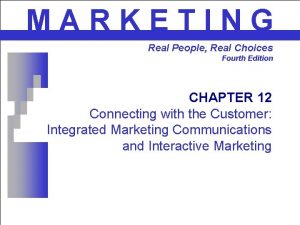Marketing Real People Real Choices Ninth Edition Chapter












































- Slides: 44

Marketing: Real People, Real Choices Ninth Edition Chapter 3 Strategic Market Planning Copyright © 2018, 2016, 2012 Pearson Education, Inc. All Rights Reserved.

Learning Objectives 3. 1 Explain business planning and its three levels. 3. 2 Describe the steps in strategic planning. 3. 3 Describe the steps in market planning. Copyright © 2018, 2016, 2012 Pearson Education, Inc. All Rights Reserved.

Real People, Real Choices: Decision Time at Oracle (1 of 2) Which option should be pursued? § Option 1: Stay the course with Oracle’s huge roster of corporate marketing clients that are very satisfied with what the company does for them. § Option 2: Acquire companies that already offer new Saa. S marketing technologies and go to market with a dedicated sales team that focuses only on selling cloud solutions. § Option 3: Continue to promote the Siebel system for basic data management functions and “deinvest” in the marketing solutions category, where it will be expensive to compete. Copyright © 2018, 2016, 2012 Pearson Education, Inc. All Rights Reserved.

Planning: Compose the Big Picture Planning is everything … almost! Business planning is an ongoing process that guides short- and long-term decisions. § Helps identify and build on firm strengths § Improves managerial decision making § Develops objectives and provides a means of charting progress toward goals Copyright © 2018, 2016, 2012 Pearson Education, Inc. All Rights Reserved.

Figure 3. 1 Three Levels of Business Planning Copyright © 2018, 2016, 2012 Pearson Education, Inc. All Rights Reserved.

Strategic Planning Strategic planning is the managerial process that matches firms resources and capabilities to market opportunities. § Top management defines firm’s purpose and sets objectives. § Many large firms have separate SBUs (strategic business units). Copyright © 2018, 2016, 2012 Pearson Education, Inc. All Rights Reserved.

Strategic Business Units (SBUs) Large, multiproduct firms may have separate divisions, called strategic business units (SBUs). § SBUs operate like a separate business. Strategic planning is conducted at both the corporate and SBU level. Copyright © 2018, 2016, 2012 Pearson Education, Inc. All Rights Reserved.

Functional Planning Functional – Planning done by top functional level management Market planning includes: § Situation analysis § Broad 3– 5 year plan to support the strategic plan § Annual plan Copyright © 2018, 2016, 2012 Pearson Education, Inc. All Rights Reserved.

Operational Planning (1 of 2) First-line managers focus on day-to-day execution of functional plan. For marketers, this typically includes § Annual, semi-annual, or even quarterly action plans to guide marketing plan implementation § Use of marketing metrics to monitor performance Copyright © 2018, 2016, 2012 Pearson Education, Inc. All Rights Reserved.

All Business Planning is an Integrated Activity Strategic, functional, and operational plans must be in harmony for firm to succeed. § Planning at all levels flows from organizational mission. Planners at all levels must keep the “big picture” in mind. Copyright © 2018, 2016, 2012 Pearson Education, Inc. All Rights Reserved.

Strategic Planning: Frame the Picture Strategic planning plays an important role in the modern corporation. § Optimize revenues across multiple lines of business. § Minimize risk in a complex and changing global environment. Includes a series of steps that results in development of growth strategies. Copyright © 2018, 2016, 2012 Pearson Education, Inc. All Rights Reserved.

Figure 3. 2 Steps in Strategic Planning Copyright © 2018, 2016, 2012 Pearson Education, Inc. All Rights Reserved.

Step 1: Define the Mission • Key questions in determining mission § What business are we in? § What customers should we serve? § How should we develop the firm’s capabilities and focus its efforts? • A mission statement is a formal document that describes the firm’s overall purpose and what it hopes to achieve in terms of its customers, products, and resources. Copyright © 2018, 2016, 2012 Pearson Education, Inc. All Rights Reserved.

Mission Statements Are Important! • Twitter’s mission statement is “To give everyone the power to create and share ideas and information instantly, without barriers. ” • The ideal mission statement is not too… § Broad § Narrow § Shortsighted Copyright © 2018, 2016, 2012 Pearson Education, Inc. All Rights Reserved.

Step 2: Evaluate the Environment • Examination of internal and external environments • Managers often synthesize environmental analysis of into a format known as SWOT analysis. § SWOT analysis catalogs firms’ internal strengths and weaknesses and external opportunities and threats. Copyright © 2018, 2016, 2012 Pearson Education, Inc. All Rights Reserved.

Internal Environment • Internal environment consists of controllable elements within firm. § Key technologies § Patents § Financial stability § Supplier relationships § Reputation § Human capital Copyright © 2018, 2016, 2012 Pearson Education, Inc. All Rights Reserved.

External Environment • External environment consists of factors outside the firm which that could positively or negatively impact operations. • Largely beyond direct management control, so planning is critical § Economy § Competition § Technology trends § Sociocultural trends § Legal/political/ethical trends Copyright © 2018, 2016, 2012 Pearson Education, Inc. All Rights Reserved.

SWOT Analysis • Strengths • Weaknesses • Opportunities • Threats Copyright © 2018, 2016, 2012 Pearson Education, Inc. All Rights Reserved.

Step 3: Set Organizational or SBU Objectives • Organizational goals and objectives should be direct outgrowth of the mission statement. § Taking into account internal and external environmental factors • Objectives should be specific, measureable, attainable, and sustainable. § May be directed toward financial- , operational- , or customer-based criteria Copyright © 2018, 2016, 2012 Pearson Education, Inc. All Rights Reserved.

Step 4: Establish Business Portfolio • A business portfolio represents the range of different businesses that a large firm operates. § Disney operates multiple lines of business, including movie studios, theme parks, cruises, etc. • Portfolio analysis § Assesses the growth potential for a firms SBUs and product lines § BCG Growth-Share Matrix Copyright © 2018, 2016, 2012 Pearson Education, Inc. All Rights Reserved.

Figure 3. 3 BCG Matrix Source: Product Portfolio Matrix, © 1970, The Boston Consulting Group. Copyright © 2018, 2016, 2012 Pearson Education, Inc. All Rights Reserved.

Step 5: Develop Growth Strategies • Product-market growth matrix § Characterizes different types of growth strategies based on market and product types. § Market penetration § Market development § Product development § Diversification Copyright © 2018, 2016, 2012 Pearson Education, Inc. All Rights Reserved.

Figure 3. 4 Product–Market Growth Matrix Copyright © 2018, 2016, 2012 Pearson Education, Inc. All Rights Reserved.

Strategic Planning Summary • Successful executives understand strategic planning as an ongoing process. • One that proceeds from defining a shared purpose, leading to business growth 1. Define the mission 2. Evaluate environment 3. Set objectives 4. Establish business portfolio 5. Develop growth strategies Copyright © 2018, 2016, 2012 Pearson Education, Inc. All Rights Reserved.

Ethical/Sustainable Decisions in the Real World • Pharmaceutical firms have various costs associated with the development of new drugs. • To offset costs, pharma companies raise the price of drugs that have no or low growth. Is it appropriate for pharma companies to set prices of prescription drugs at any level they want based on the needs of the business? Copyright © 2018, 2016, 2012 Pearson Education, Inc. All Rights Reserved.

Market Planning: Develop and Execute Marketing Strategy • Effective implementation of the four Ps requires a great deal of planning. • Steps are similar to those in strategic planning § Key difference relates to focus on issues relating to marketing mix. Copyright © 2018, 2016, 2012 Pearson Education, Inc. All Rights Reserved.

Figure 3. 5 Steps in Market Planning Copyright © 2018, 2016, 2012 Pearson Education, Inc. All Rights Reserved.

Step 1: Perform a Situation Analysis • Analyze the marketing environment • Conduct SWOT analysis Copyright © 2018, 2016, 2012 Pearson Education, Inc. All Rights Reserved.

Step 2: Set Marketing Objectives • Specific to the firm’s marketing mix-related elements • Marketing objectives help achieve the overall business objectives. Copyright © 2018, 2016, 2012 Pearson Education, Inc. All Rights Reserved.

Step 3: Develop Marketing Strategies • Identify target market(s) • Adjust marketing mix for each target market § Product § Price § Promotion § Place (Distribution) Copyright © 2018, 2016, 2012 Pearson Education, Inc. All Rights Reserved.

Product Strategies • Product strategies include decisions on: § Product design § Packaging § Branding § Support services and maintenance § Upgrades § Product variations Copyright © 2018, 2016, 2012 Pearson Education, Inc. All Rights Reserved.

Pricing Strategies • Pricing strategy determines how much a firm charges for a product. § A firm may base its pricing strategy on costs, demand, price of competing products. § Debundling Copyright © 2018, 2016, 2012 Pearson Education, Inc. All Rights Reserved.

Promotional Strategies • Promotional strategy is how marketers communicate a product’s value proposition to the target market. § Advertising § Sales promotion § Public relations § Direct marketing § Personal selling Copyright © 2018, 2016, 2012 Pearson Education, Inc. All Rights Reserved.

Distribution Strategies • Distribution strategies (the place component) outline when, how, and where the firm will make the product available to targeted customers. § Sell directly to the final customer or work through wholesalers and retailers? § Choosing the right distribution strategy depends on product, pricing, and promotion decisions. Copyright © 2018, 2016, 2012 Pearson Education, Inc. All Rights Reserved.

Step 4: Implement and Control the Marketing Plan • During implementation process, firms follow formal process to determine progress toward marketing objectives. § Measure actual performance § Compare performance to established objectives § Make adjustments to objectives or strategies based on this analysis Copyright © 2018, 2016, 2012 Pearson Education, Inc. All Rights Reserved.

Return on Marketing Investment (ROMI) • Return on marketing investment § Revenue (or profit) generated by investment in a given marketing program divided by the cost of the program at a given level of risk § For instance, if: § Revenue from Marketing Investment = $150, 000 § Cost of Marketing Program = $30, 000 § ROMI = 5. 0 Copyright © 2018, 2016, 2012 Pearson Education, Inc. All Rights Reserved.

Action Plans • Individual support plans included in a marketing plan that provide guidance for implementation and control of the various marketing strategies within the plan. § Sometimes referred to as marketing programs § Managers create actions plans for key elements involved in implementing the marketing strategy. Copyright © 2018, 2016, 2012 Pearson Education, Inc. All Rights Reserved.

Table 3. 1 Template for an Action Plan Title of action plan Purpose of action plan Give the action plan a relevant name. What do you hope to accomplish by the action plan—that is, what specific marketing objective and strategy within the marketing plan does it support? Description of action plan Be succinct—but still thorough—when you explain the action plan. What are the steps involved? This is the core of the action plan. It describes what must be done in order to accomplish the intended purpose of the action plan. Responsibility for the action plan What person(s) or organizational unit(s) are responsible for carrying out the action plan? What external parties are needed to make it happen? Most importantly, who specifically has final “ownership” of the action plan—that is, who within the organization is accountable for it? Provide a specific timetable of events leading to the completion of the plan. If different people are responsible for different elements of the time line, provide that information. How much will implementation of the action plan cost? This may be direct costs only or may also include indirect costs, depending on the situation. The sum of all the individual action plan budget items will ultimately be aggregated by category to create the overall budget for the marketing plan. Timeline for the action plan Budget for the action plan Measurement and control of the action plan Indicate the appropriate metrics, how and when they will be measured, and who will measure them. Copyright © 2018, 2016, 2012 Pearson Education, Inc. All Rights Reserved.

Assigning Responsibility in the Action Plan • Who will be responsible for carrying out each part of the marketing plan? • Not everybody involved will be marketers § § § § Sales Production Quality control Shipping Customer service Finance IT Copyright © 2018, 2016, 2012 Pearson Education, Inc. All Rights Reserved.

Creating Action Plan Timelines • Each action plan requires a time line needed to accomplish the various tasks. • Often portrayed in flowchart form to help managers and employees visualize sequence of tasks § Gantt charts § PERT charts Copyright © 2018, 2016, 2012 Pearson Education, Inc. All Rights Reserved.

Setting a Budget • Each cost element of the action plan should link to a budget item. § Increases accountability for all parties involved with implementing the marketing plan § Accuracy in estimating individual action plan expenditures helps overall marketing budget forecasting. Copyright © 2018, 2016, 2012 Pearson Education, Inc. All Rights Reserved.

Deciding on Measurements and Controls • Marketing control is a formal process for: § Measuring performance § Comparing performance to established marketing and strategy objectives § Making adjustments to the objectives or strategies based on this analysis • Selecting the right metrics should account for shortterm objectives balanced against firm’s long-term sustainability. Copyright © 2018, 2016, 2012 Pearson Education, Inc. All Rights Reserved.

Operational Planning (2 of 2) • Operational plans focus on day-to-day execution of the marketing plan. § Cover a shorter period of time than strategic and functional plans § Often falls to lower level managers § Include detailed instructions for activities, specifies responsibilities, and provides time lines § Many key marketing metrics actually are used at the operational level of planning. Copyright © 2018, 2016, 2012 Pearson Education, Inc. All Rights Reserved.

Copyright © 2018, 2016, 2012 Pearson Education, Inc. All Rights Reserved.
 Slidetodoc.com
Slidetodoc.com Marketing: real people, real choices
Marketing: real people, real choices Marketing real people real choices
Marketing real people real choices Levels of analysis psychology
Levels of analysis psychology Macroeconomics ninth edition
Macroeconomics ninth edition Anatomy and physiology ninth edition
Anatomy and physiology ninth edition General adaptation syndrome
General adaptation syndrome Social psychology ninth edition
Social psychology ninth edition Biology ninth edition
Biology ninth edition Child development ninth edition
Child development ninth edition Berk 2013 child development
Berk 2013 child development Lysanx
Lysanx Psychology ninth edition in modules
Psychology ninth edition in modules Psychology ninth edition david g myers
Psychology ninth edition david g myers Biology ninth edition
Biology ninth edition Campbell ninth edition
Campbell ninth edition Marketing real people real decisions
Marketing real people real decisions Marketing real people real decisions
Marketing real people real decisions Examples of reactive language
Examples of reactive language Reactive people make choices based on
Reactive people make choices based on Whats proactive
Whats proactive Reactive language vs proactive language
Reactive language vs proactive language How do nationalist loyalties shape people's choices
How do nationalist loyalties shape people's choices How do nationalist loyalties shape people's choices
How do nationalist loyalties shape people's choices Marketing real people
Marketing real people The six chief commandments of the catholic church
The six chief commandments of the catholic church The sixth and ninth commandments
The sixth and ninth commandments Photo/phos root word
Photo/phos root word Whats a ramadan
Whats a ramadan William blount 9th grade academy
William blount 9th grade academy Lower ninth ward
Lower ninth ward Accompaniment for canenton roti
Accompaniment for canenton roti Ninth district pta
Ninth district pta Using mis (10th edition) 10th edition
Using mis (10th edition) 10th edition Zulily case study
Zulily case study Lesson 2 making responsible decisions and setting goals
Lesson 2 making responsible decisions and setting goals Lesson 2 our economic choices
Lesson 2 our economic choices Chapter 9 making healthy food choices
Chapter 9 making healthy food choices Chapter 1 how your choices affect income answer key
Chapter 1 how your choices affect income answer key Chapter 1 section 3 economic choices and decision making
Chapter 1 section 3 economic choices and decision making Society's economizing problem involves
Society's economizing problem involves Marketing management (arab world edition) philip kotler
Marketing management (arab world edition) philip kotler What is the value delivery process
What is the value delivery process Marketing management (arab world edition) philip kotler
Marketing management (arab world edition) philip kotler What are the keys to effective internal marketing
What are the keys to effective internal marketing

